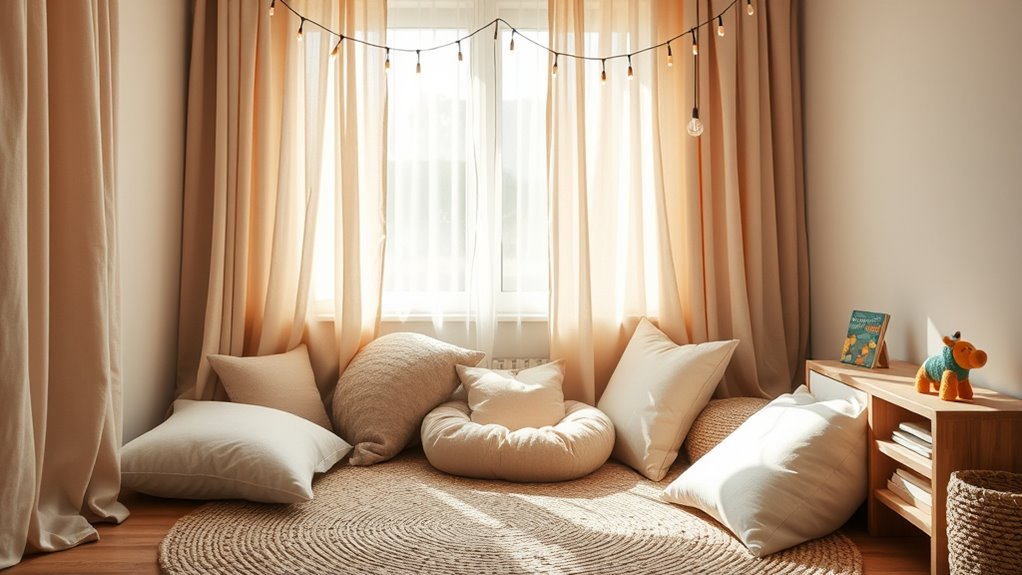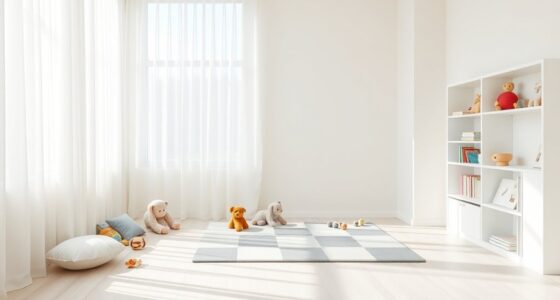To create a calming corner kids will actually use, choose a quiet, low-traffic spot and make it cozy with soft cushions, plush rugs, and calming colors. Include sensory tools like textured fidget toys, soft blankets, and gentle lighting that kids can access easily and independently. Let children personalize the space with their favorite items, and keep it organized and inviting. Keep the area fresh, clean, and simple—when done right, kids will naturally turn to this peaceful retreat whenever needed. Keep going to discover more ways to make it truly effective.
Key Takeaways
- Choose a quiet, low-traffic spot to help children associate the area with peace and privacy.
- Incorporate soft, inviting decor like cushions, plush rugs, and calming colors to make the space welcoming.
- Include sensory tools such as textured toys, calming lights, and soft blankets that children can easily access and use independently.
- Involve children in decorating and selecting tools to increase their attachment and encourage regular use.
- Keep the space clean, organized, and periodically refreshed to maintain appeal and ensure children feel comfortable using it.

Have you ever noticed how some kids need a quiet space to regroup during stressful moments? Creating a calming corner can give them that safe haven, helping them manage their emotions and regain focus. To make this space inviting and effective, it’s essential to include sensory tools and cozy decor. Sensory tools, like soft blankets, textured fidget toys, or calming lights, provide tactile and visual stimuli that help kids soothe themselves. These tools can be especially helpful for children who seek sensory input or become overwhelmed easily. When choosing sensory tools, pick items that are safe, durable, and easy to access, so your child feels empowered to use them whenever needed. Incorporating distraction techniques into the space can also help children shift their focus during heightened emotional states.
Creating a calming corner with sensory tools and cozy decor helps children manage stress and regain focus effectively.
Cozy decor plays a pivotal role in transforming an ordinary corner into a welcoming retreat. Think soft cushions, plush rugs, and gentle lighting to create a warm, inviting atmosphere. The goal is to make the space feel safe and comfortable, encouraging your child to retreat without hesitation. Use calming colors like soft blues, gentle greens, or warm neutrals to promote relaxation. Including personal touches, such as favorite stuffed animals or calming artwork, can make the space feel more personalized and comforting. The decor should be simple yet inviting, avoiding clutter that could distract or overwhelm.
Position the calming corner in a quiet part of your home, away from noisy areas and high-traffic zones. This helps your child associate the space with peace and privacy. Keep sensory tools organized and within easy reach, perhaps in a small basket or a dedicated shelf. Teaching your child how to use these tools during moments of stress empowers them to self-regulate and builds independence. Remember, the goal isn’t just to create a space but to make it a practical, go-to resource that your child feels comfortable using whenever they need a break.
Involving your child in decorating the calming corner can increase their attachment to it. Let them choose some decor items or sensory tools that appeal to them. This ownership encourages regular use and helps them recognize the space as a safe retreat. Keep the area clean and inviting, and periodically refresh the sensory tools or decor to maintain their appeal. When thoughtfully designed with sensory tools and cozy decor, your calming corner becomes a supportive tool for emotional regulation, giving your child a peaceful refuge amid the chaos of daily life.
Frequently Asked Questions
How Do I Introduce the Calming Corner to My Child?
You should introduce the calming corner gradually, explaining its purpose and benefits to your child. Use positive reinforcement by praising them when they explore or use the space, encouraging their comfort. Let your child decide when to visit and how long to stay, making it a safe, welcoming spot. Over time, they’ll see the calming corner as a helpful tool for managing emotions, creating a positive association.
What if My Child Refuses to Use the Calming Corner?
Think of the calming corner as a secret garden your child can explore when emotions run high. If they refuse to use it, don’t push too hard; instead, gently guide them and model emotional regulation yourself. Use positive behavior management, praising even small steps toward calmness. Over time, your child may see it as a safe space for emotional regulation, making them more willing to engage naturally.
How Can I Customize the Calming Corner for Different Age Groups?
To customize the calming corner for different age groups, choose age-appropriate decor and sensory toys that suit each child’s needs. For younger kids, use soft pillows, colorful visuals, and gentle music. For older children, incorporate calming books, fidget tools, and minimalistic decor. Adjust the space regularly to keep it inviting and relevant, ensuring each child feels comfortable and engaged in their calming environment.
Are There Specific Items That Should Always Be Included?
You should always include comfort items like soft blankets or stuffed animals and sensory tools such as fidget spinners or textured toys. These items help children self-regulate and feel safe. Keep a variety of sensory tools accessible to cater to different preferences, and choose comfort items that are familiar and soothing. Having these essentials guarantees the calming corner becomes a reliable space for kids to relax and regain focus.
How Often Should I Update or Change the Calming Corner?
Think of your calming corner as a garden that needs regular tending. You should update or change it every few months to keep it fresh and inviting. Follow a maintenance schedule that includes decoration updates, replacing worn-out items, and adding new calming tools. This ongoing care guarantees kids stay engaged and find comfort easily. Regular updates make the space feel lively, welcoming, and ready for little ones whenever they need it.
Conclusion
Creating a calming corner helps children develop emotional regulation skills, making a real difference in their daily lives. Research shows that kids who have designated calming spaces experience 30% fewer behavioral outbursts. By thoughtfully designing this space, you give your child a place to self-soothe and regain composure. Remember, a calming corner isn’t just a nice-to-have—it’s a powerful tool that supports their overall well-being and resilience. Start creating yours today, and watch your child’s confidence grow.










